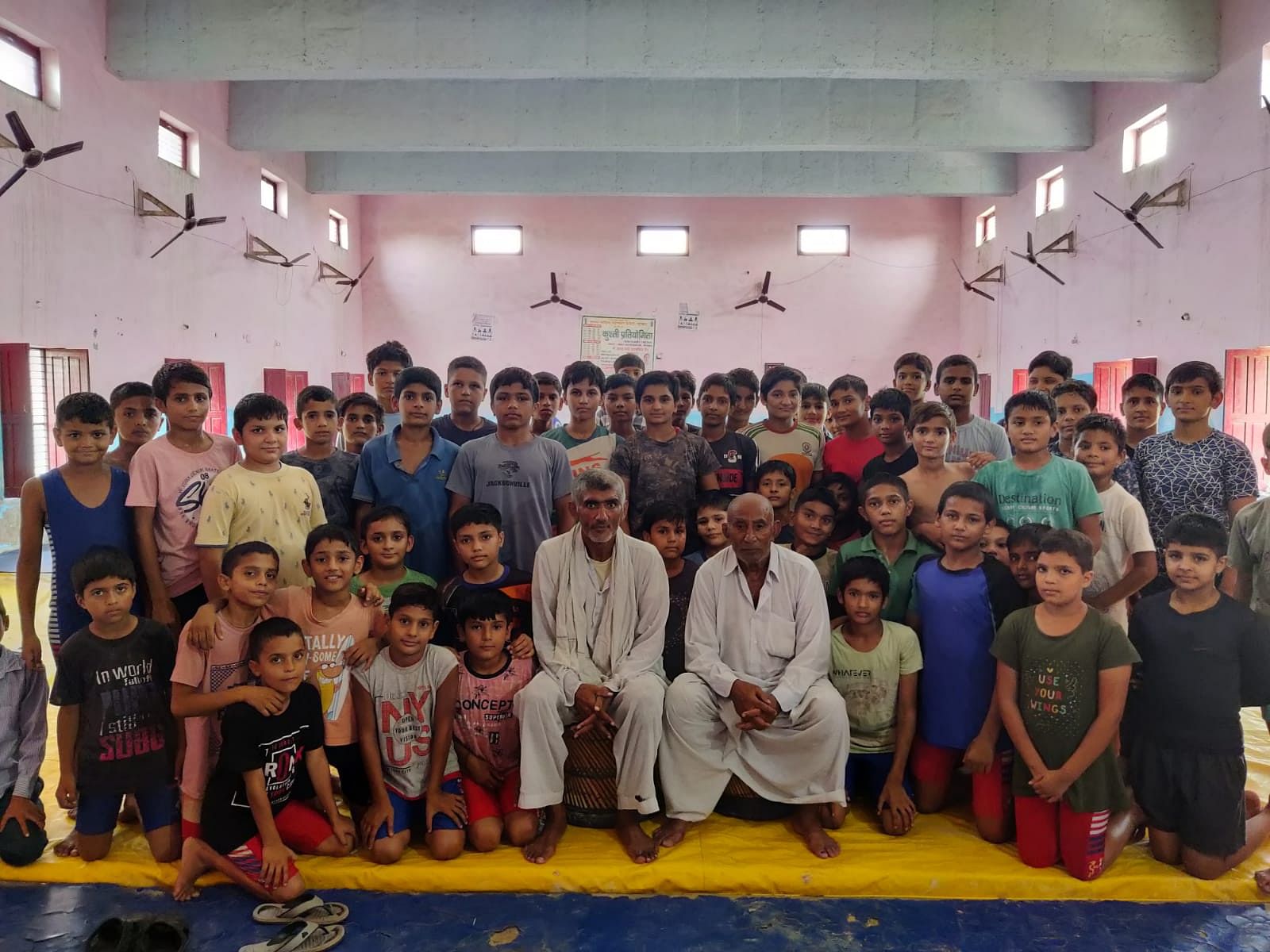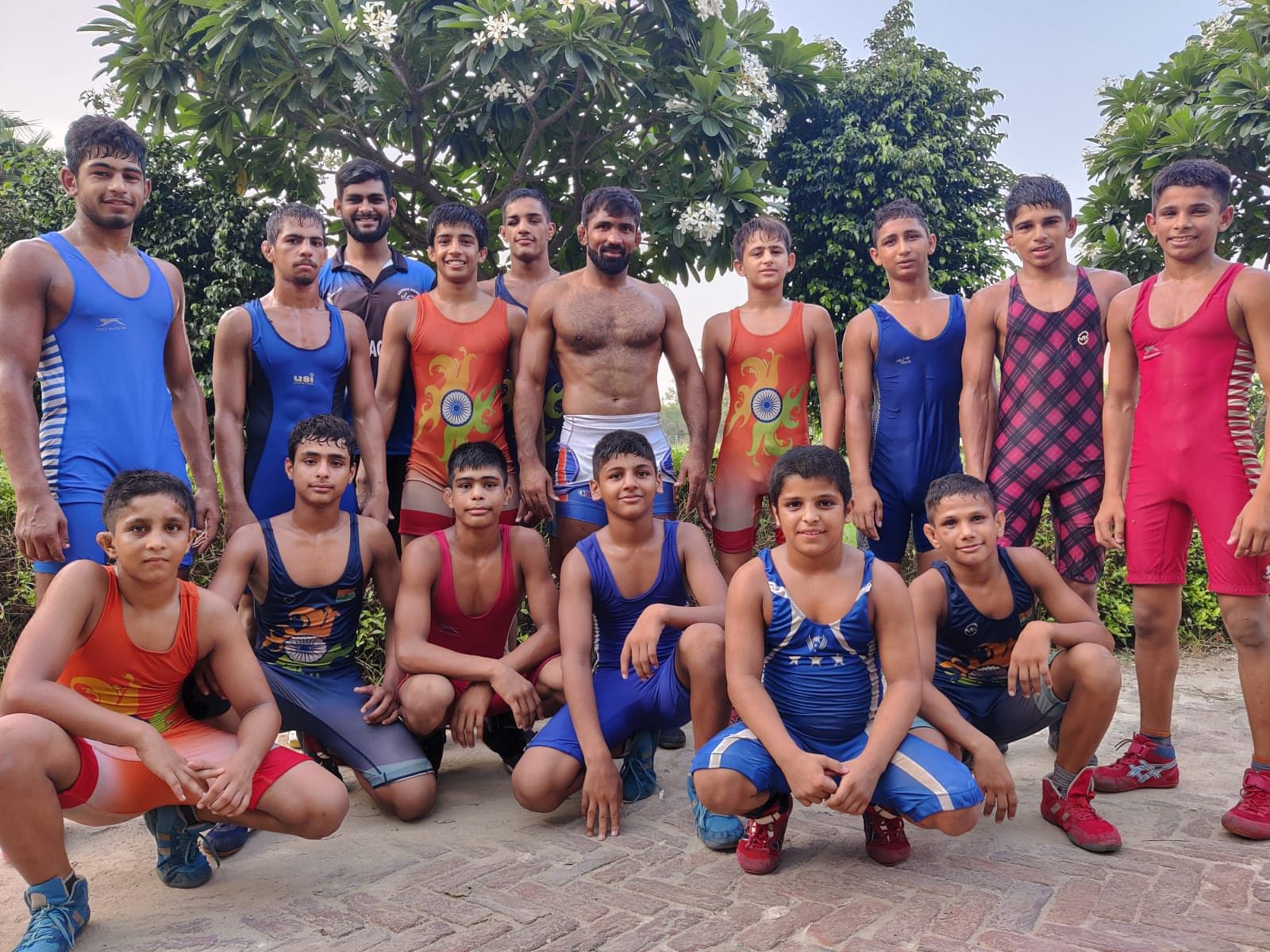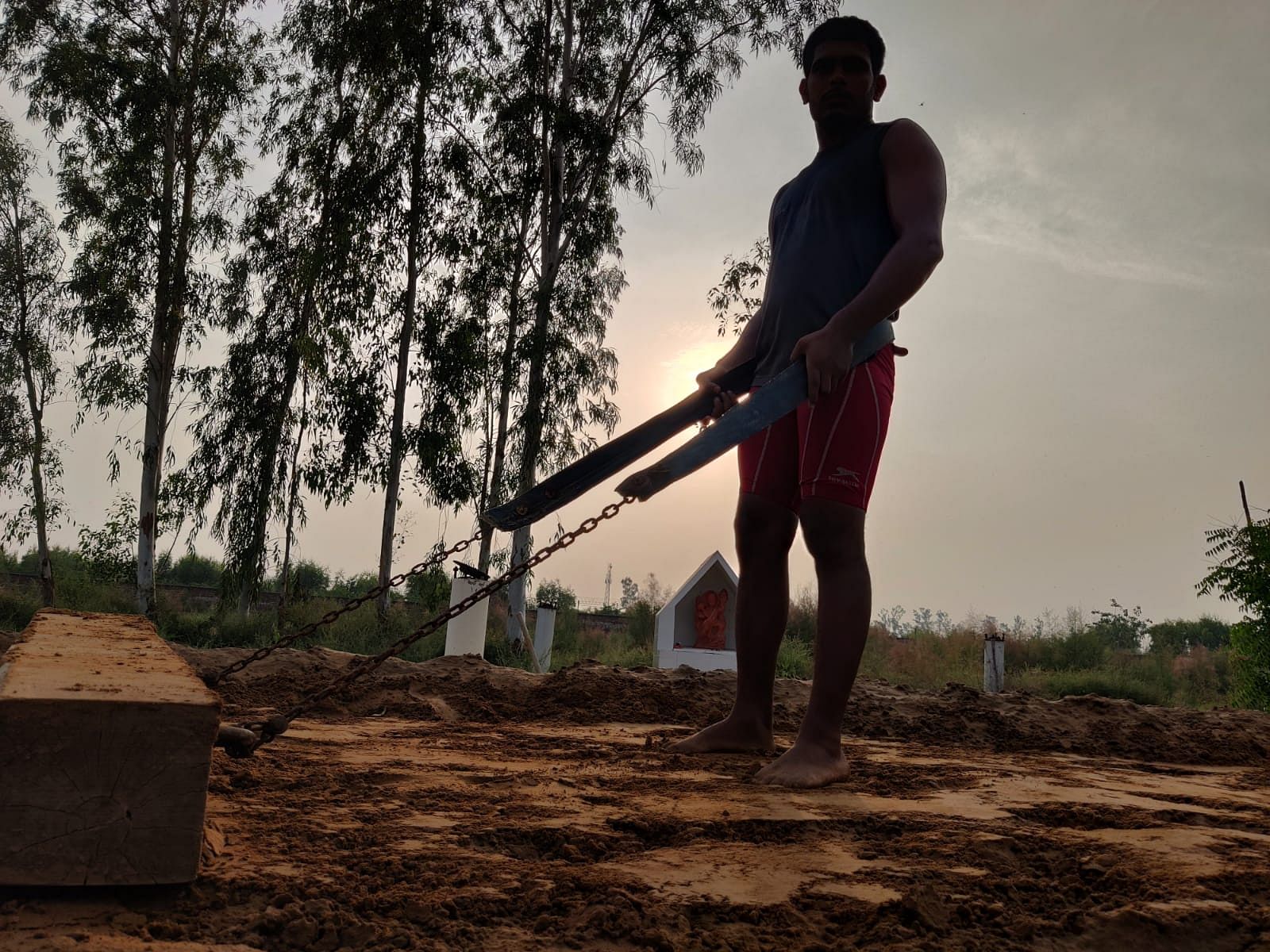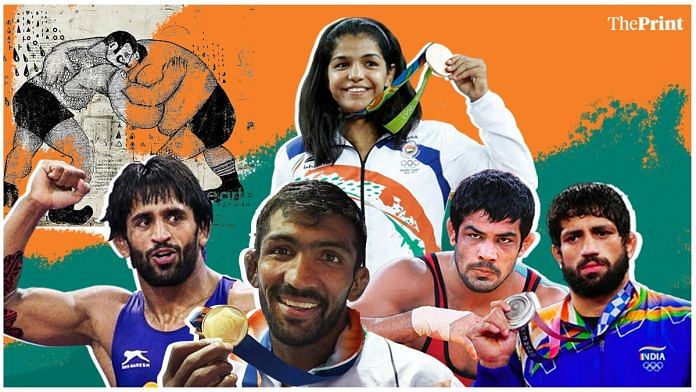Rohtak/Sonipat: It’s 3:30 pm and a hot, humid August afternoon hangs heavy over Mokhra village in Haryana. The roads look deserted. Except some young men and women, drenched in sweat, are cycling to Shankar Vyayamshala, the village’s local akhada.
The women are new entrants to the akhada. Until about five years ago, the akhada was strictly for men. The women started training here only after one of their own, Sakshi Malik became an Olympic champion.
Malik’s bronze at the 2016 Rio Olympics brought about a change of heart among the villagers, who urged the local coach, 83-year-old Maaria Pehelwan, to open the gates for women as well.
“In our times, we didn’t allow girls anywhere near an akhada, even if anyone entered by mistake, we would cleanse the mud pit with dhoop batti and do puja,” Maaria tells ThePrint. “But looking at so many girls eager to wrestle, I gave up and let them all train here. Times are changing.”

But this “change” hasn’t come just within a single Olympic cycle. Since 2008, India has made wrestling one of its top sports at the summer games, winning a total of six medals — the most in any sport in this period.
In 2008, Sushil Kumar won the bronze in Beijing. He followed it up with a silver in London. But there, he found the company of Yogeshwar Dutt, who won a bronze. Then came Malik’s splash at the Rio games. Last month, wrestlers contributed two medals to India’s Tokyo 2020 tally of seven medals — a silver for Ravi Kumar Dahiya and a bronze for Bajrang Punia.
Success has also been achieved at the World Championships. While Sushil Kumar remains the only Indian wrestler to have won a gold there, India has also won 3 silver and 9 bronze medals. Eleven of these 13 medals came over the last decade.
Earlier this year, Mokhra’s 16-year-old Tanu Malik won a gold in the 43-kg freestyle category at the World Cadet Championships held in Budapest, Hungary.
“When I saw Sakshi’s grand welcome in the village, I decided then and there that I want to wrestle too. I was disappointed to know that I couldn’t (before women were allowed inside the akhara). And without Sakshi winning a medal, I wouldn’t have been able to pursue it either,” Tanu tells ThePrint.
But this isn’t just Mokhra’s story. The country’s Olympics success in wrestling has brought a paradigm shift in the approach to the sport and available infrastructure in the hinterlands of Haryana, which is now firmly the Indian wrestling capital.
Also read: Mud, medals, money, even murder – Inside India’s secretive akhadas, beyond Sushil Kumar
The Sushil Kumar effect
Ranbir Dhaka, a former Sports Authority of India (SAI) coach at Mehar Singh Akhada in Rohtak, says medals in the Olympics have made what were once unfathomable dreams a reality now.
“Sushil and Yogeshwar medals in the Olympics changed the world of wrestling for good. Before their victories wrestlers went to the Olympics like mere tourists to a foreign country. Nobody thought we could actually beat the Uzbeks and the Russians on the wrestling mat. In 2008, Sushil opened a magic gate for us, I am eternally grateful to him,” Dhaka says.
Kumar’s medal came 56 long years after K.D. Jadhav’s bronze in wrestling at the 1952 Helsinki games. His success in Beijing led to a resurgence in the sport and the akhadas started seeing much more enthusiastic enrolment of young men in the game.
“I had 100 students here (at Mehar Singh Akhada) before 2008. Immediately after Sushil’s medals, so many interested boys came to my akhada that I had to even reject some applications. Right now, there are 250 boys here,” says Dhaka.
Earlier this year, the two-time Olympic champion was arrested and charge-sheeted for his alleged involvement in the murder of wrestler Sagar Dhankar in Delhi’s Chhattrasal Stadium.
While it would be presumed that the allegations would tarnish his image in the eyes of the wrestling community of Haryana, it hasn’t really. The general consensus is that Sushil pehelwan’s contribution and success outweigh the one “small” mistake he made.
Also read: Sushil Kumar sought to re-establish supremacy among young wrestlers — Delhi Police charge sheet
Post-2008 wrestling world
The akhada culture has always been prevalent in Haryana, where every village has a wrestling pit, and those who want to pursue the sport seriously move to bigger residential wrestling schools.
The Olympians from the state have now opened akhadas for anyone who wants to learn.
Yogeshwar Dutt has opened a school near his native village in Gohana, Sonipat, while Olympian Amit Dahiya has opened one near Khewra village in the same district.
Mahavir Phogat Sports Academy, named after wrestler Mahavir Phogat who was portrayed by actor Aamir Khan in the biopic Dangal, is also a popular wrestling school, especially for women, in Balali village in Charkhi-Dadri district.
The average monthly fees of these akhadas is nominal — anywhere in the range of Rs 4,000-5,000. But that doesn’t cover the entire cost of the food a wrestler needs to eat, including items like milk, almonds, ghee etc. Hopeful parents often travel 70-80 km a day to bring food to their kids at these akhadas.
Renu Tomar from Baraut in Uttar Pradesh is one such parent. Her son Badal decided to be a wrestler in 2012, after he was introduced to the game on television during the London Olympics.
“When we heard an Olympic champion like Yogeshwar ji is opening his academy we shifted to Sonipat so Badal can realise his dream. His only goal is an Olympic medal and he’s working towards it. I am very proud of him,” says Tomar.
To pursue this dream, Badal had to give up formal education. But Indian victories at the Olympics boosted his family’s confidence in letting him make that choice.
“My parents are very supportive. They believe if I train under an Olympic champion, I too will be able to win a medal for team India at future Olympic games. Without India’s consistent success at wrestling, they wouldn’t have been so encouraging,” he tells ThePrint.
Dutt is hopeful of opening another academy — fully owned by him, unlike the first one, which is on lease — sprawling over 8 acres in Gohana, which will house both men and women.
“I just think of all the facilities that weren’t available to me and I think of providing them to the next generation so they don’t struggle in a similar fashion. The potential of wrestling in Haryana is immense, we can double the number of medals we brought home this year,” Dutt tells ThePrint.

Also read: Sumit Antil bags India’s second gold at Paralympics, sets world record in javelin throw
Better infrastructure at akhadas
The cultural shift has been duly noted by the state government, which is also aiding privately run akhadas in its own capacity.
India didn’t have an Olympic mat till as late as 1992, and wrestlers used to train on jute mats, which made them vulnerable to injuries.
In his book ‘Enter the Dangal’, journalist Rudraneil Sengupta writes that there were less than 10 mats in government-run wrestling schools till 1992, and all of them were thin jute ones with “little resemblance to Olympic mats”.
The first Olympic mat came to India in 1999, one year after Sushil Kumar’s under-18 win at the 1998 World Cadet Championship, where he won a gold medal.
Today, Olympic mats are no distant dream, they are available in small akhadas in rural India too.
Sponsoring these Olympic mats also help politicians gain clout. “Politicians in Haryana must — almost compulsorily — sponsor an akhada and furnish it with an Olympic mat if they want influence over their electorate,” Sengupta writes.
After the success of Dangal in 2016, the Manohar Lal Khattar government donated 100 wrestling mats to various akhadas in the state. But these incur a high maintenance cost.
“We have to change the sheet covering the mats every six months, which alone costs anywhere between Rs 70,000 and 80,000, and we have to do this on our own time. I’d urge the government to help us out in this regard,” Dhaka says.
He also urges the government to identify talent first-hand so that the state can give birth to even more Olympic champions.
“We go on giving money to Olympic champions… that’s a good thing, but that doesn’t help at all. The government needs to identify good players at sub-junior levels and assist them monetarily, ensuring they have access to good diets. A lot of athletes are from poor households and are unable to eat properly,” he says.
“Centre and state go on celebrating once a champion is made. But what are they doing about the talent that is dying before it can realise its full potential?” asks Dhaka.
Government efforts
Pankaj Nain, head of Haryana’s sports and youth department, notes that the government supports the private akhadas.
“We provide them government coaches and provide necessary equipment too for the kids and the coaches. It’s not all black and white, the government is doing its best to make use of already available infrastructure and increase its potential,” he says.
The Haryana government is also opening indoor stadiums at Nahri village in Sonipat and Khudan village in Jhajjar district — the native villages of Ravi Dahiya and Bajrang Punia, respectively.

The state government is also planning to open a centre for excellence in Rohtak to provide ground-level support to akhadas so they can give international-level coaching facilities to their children.
The government is intent on reviving nurseries — residential sports academies for children under 14 — that have been suspended due to the Covid pandemic. According to Nain, 1,000 sports nurseries have already been sanctioned by the government in Haryana.
“Currently there are 150 academies which will soon be increased. At these nurseries, we are also planning to give a stipend of Rs 2,000-2,500 to 25 students per nursery, which will encourage parents to enroll their kids here,” he tells ThePrint.
Neeraj Chopra, India’s first Olympic champion in athletics who won a gold in javelin throw at Tokyo games last month, is the product of one such nursery in Panchkula.
The journey elsewhere
Back in Mokhra, Tanu is the next whiz-kid. Villagers hope she will get them a medal at the Olympics.
“I’ve been watching her train since the beginning. She’s never missed a day. I bet she will make this village proud like Sakshi did and win a medal at the Olympics,” says Navdeep Malik, a former soldier in the Army who trains at the akhada.
Malik’s success has changed the mood in the surrounding villages as well. Girls cycle to Shankar Vyayamshala from Medina, Gadd, Basana and Badamba, because few local akhadas allow female wrestlers.
For Maaria Pehelwan, this has also meant that he has had to overcome a lot of prejudices. “Earlier I thought girls in wrestling weren’t acceptable at all. But today I feel proud of my students, I am happy when I see them train diligently,” he tells ThePrint.
From not allowing girls in the wrestling pit to welcoming students from other villages, Mokhra tells the true worth of an Olympic medal.
(Edited by Amit Upadhyaya)
Also read: For India’s revolutionaries in freedom struggle, gyms & akharas were a cover for politics






